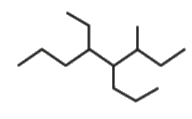From the following E∘ values of half- cells :
(i). A+e→A−,E∘=−0.24V
(ii) B−+e→B2−:E∘=+1.25V
(iii) C−+2e→C3,E∘=−1.25V
(iV). D+2e→D2−,E∘=+0.68V
If you were to construct a cell using combination of two half- cells from above that gives the
largest cell potential. then value of the largest cell potential would be ____ V.
The correct Answer is:2.50
Larger the difference between the electrode potentials, greater is the cell potential. Hence. Combination of
half-cells (ii) and (iii) will give the largest cell potential.
Ecll∘=Ecalsade∘−Ermak∘=1.25−(−1.25)=+2.50V
Topper's Solved these Questions
- NTA TPC JEE MAIN TEST 98BOOK - NTA MOCK TESTSCHAPTER - NTA TPC JEE MAIN TEST 98EXERCISE - Chemistry (SUBJECTIVE NUMERICAL)
9 Videos
- NTA TPC JEE MAIN TEST 94BOOK - NTA MOCK TESTSCHAPTER - NTA TPC JEE MAIN TEST 94EXERCISE - CHEMISTRY
30 Videos
- ORGANIC CHEMISTRY - SOME BASIC PRINCIPLES AND TECHNIQUES TESTBOOK - NTA MOCK TESTSCHAPTER - ORGANIC CHEMISTRY - SOME BASIC PRINCIPLES AND TECHNIQUES TESTEXERCISE - SINGLE CHOICE
30 Videos
Similar Questions
Total number of colourless gases in the given list are
CO2(g),Cl2(g),SO2(g),HCl(g),
Br2 vapor,NO2(g),I2 vapor,H2S(g)
View SolutionWhich is the incorrect order of bond angle :-
View SolutionThe correct IUPAC name of the folllowing hydrocarbon is

View SolutionDeduce from the following Ec− values of half cells, what combination of two half cells would results in a cell with the largest potential?
I.A+e(−)→Ac−Ec−=−0.24VII.Bc−+e−→B2−Ec−=+1.25VIII.Cc−+2e−→C3−Ec−=−1.25VIV.D+2ec−→D2−Ec−=+0.68V
View SolutionConsider following half cell reaction and corresponding standard (reduction) electrode potentials. I. A+e^(-)rarrA:E^(@)=-24V II. B^(-)+e^(-)rarrB^(2-):E^(@)=+1.25V III. C^(-)+2e^(-)rarrC^(3-):E^(@)=-1.25V IV. D+2e^(-)rarrD^(2-):E^(@)=+0.68V V. E+4e^(-)rarrE^(-4):E^(@)=0.38V . Cell with the largest cell potential is
View SolutionConsider following half cell reaction and corresponding standard (reduction) electrode potentials. I. A+e^(-)rarrA:E^(@)=-24V II. B^(-)+e^(-)rarrB^(2-):E^(@)=+1.25V III. C^(-)+2e^(-)rarrC^(3-):E^(@)=-1.25V IV. D+2e^(-)rarrD^(2-):E^(@)=+0.68V V. E+4e^(-)rarrE^(-4):E^(@)=0.38V . If every ion has concentration 1 M in the cell the largest cell potential at 298K is
View SolutionFrom the following E^(o) value of helf cells: (i) A+e^(-)rarr A ^(-) , E^(o) = -0.824 V (ii) B^(-)+e^(-)rarr B ^(2-) , E^(o) = +1.25V (iii) C^(-)+2e^(-)rarr C ^(3-) , E^(o) = -1.25V (iv) D^(-)+2e^(-)rarr D ^(2-) , E^(o) = +0.68V What combination of two half cells would result is a cell with the largest cell potential?
View SolutionHalf cell reactions for some electrodes are given below I. A + e^(-) rarr A^(-) , E^(@) = 0.96V II. B^(-) + e^(-) rarr B^(2-) , E^(@) = -0.12V III. C^(+) + e^(-) rarr C, E^(@) =+0.18V IV. D^(2+) + 2e^(-) rarr D, E^(@) = -1.12V Largest potential will be generated in which cell?
View SolutionDeduce from the following E∘ values of half cells, what combination of two halt would resutlt in a cell with the largenst potential :
(i)A+e→A,E∘=−0.24V
(ii) B−+e→B2−,E∘=+1.25V
(iii) C−+2e→C3−,E∘=−1.25V
(iv) D+2e→D2−,E∘=+0.68V
View SolutionDeduce from the following E^@ values of half cells, what combination of two halt would resutlt in a cell with the largenst potential : (i) Ararr A^+ +e ,E^@=+1.2V (ii) B^-rarrB+e,E^@=-2.1V (iii) CrarrC^(2+) +2e,E^@=-0.38V (iv) D^(2-) rarrD^- +e,E^@=-0.59V
View SolutionDeduce from the following E^@ values of half cells , what combination of two half cells would result in a cell with largest potential : (i) A^(3-) rarr A^(2-) + e^- , E^@=1.5 V (ii) B^(2+) +e^- rarrB^+ ,E^@ =-2.1V (iii) C^(2+)+e^- rarrC^+,E^@=+0.5V (iv) DrarrD^2 +2e^-,E^@=-1.5V
View SolutionDeduce from the following E^@ values of half cells, what combination of two halt would resutlt in a cell with the largenst potential : (i) A+e rarr A ,E^@=-0.24V (ii) B^- +e rarrB^(2-),E^@=+1.25V (iii) C^- +2erarrC^(3-),E^@=-1.25V (iv) D + 2e rarrD^(2-), E^@=+ 0.68V
View SolutionDeduce from the following E^@ values of half cells, what combination of two halt would resutlt in a cell with the largenst potential : (i) Ararr A^+ +e ,E^@=+1.2V (ii) B^-rarrB+e,E^@=-2.1V (iii) CrarrC^(2+) +2e,E^@=-0.38V (iv) D^(2-) rarrD^- +e,E^@=-0.59V
View SolutionDeduce from the following E∘ values of half cells , what combination of two half cells would result in a cell with largest potential :
(i) A3−→A2−+e−,E∘=1.5V
(ii) B2++e−→B+,E∘=−2.1V
(iii)C2++e−→C+,E∘=+0.5V
(iv)D→D2+2e−,E∘=−1.5V
View SolutionFrom the following E^@ values of half cells, (i) A+e to A^(-) , E^@=-0.24V (ii) B^(-) +e to B^(2-) , E^@=+1.25V (iii) C^(-) +2e to C^(3-) , E^@=-1.25V (iv) D+2e to D^(2-) , E^@=+0.68V What combination of two half cells would result in a cell with the largest potential?
View SolutionFrom the following E^@ values of half cells (i) A to A^(+)+e, E^@=+1.2V (ii) B^(-) to B+e, E^@=-2.1V (iii) C to C^(2+) +2e, E^@=0.38V (iv) D^(-2) to D^(-) +e, E^@=-0.59V What combination of two half cells would result in a cell with the largest potential?
View Solution
